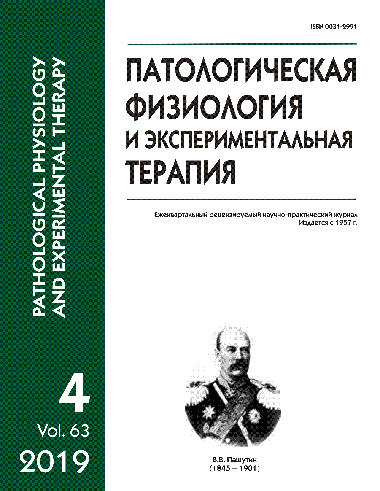Antibodies to enzymes of antioxidant system as a pathogenetic component of anemia in rheumatoid arthritis
Abstract
The aim was to study formation of antibodies to superoxide dismutase (SOD), glutathione reductase (GR), and catalase (CAT) in patients with rheumatoid arthritis (RA) and to elucidate the role of the antibodies in development of anemia. Methods. The antibodies were determined by enzyme-linked immunosorbent assay (ELISA) using immobilized magnetic sorbents, polyacrylamide granules containing a magnetic substance and the enzymes (SOD, GR, CAT) as antigens. Antibody concentration was expressed in absorbance units. Rheumatoid arthritis was diagnosed based on clinical and instrumental evaluation of patients according to the criteria of the American College of Rheumatology (ACR/EULAR, 2010). Statistical analysis was performed using variation statistics, and results were expressed as mean±SEM. Central tendencies were compared using the Student’s test. Differences were considered statistically significant at p<0.05. ELISA was performed on blood serum from 104 rheumatoid arthritis patients with different disease activity. The following commercial reagents (Russia) were used as antigens: superoxide dismutase from human RBCs (30 U/mg), which was used in the study in a working protein dilution of 100 mcg/ml; glutathione reductase (340 U/mg) which was used in the study at a protein concentration of 200 mg/ml; and catalase (380 U/mg), which was used in the study at a protein concentration of 1.4 mg/ml. Since the relative molecular weights of glutathione reductase and catalase were sufficient, immobilization was performed by emulsion polymerization in a flow of gaseous nitrogen including a magnetic material. Due to a low relative molecular weight of SOD from RBCs this enzyme was immobilized by coupling to an inert polyacrylamide granule containing a magnetic material, using glutaric aldehyde. «Pure» antibodies to the enzymes were obtained using a respective antigen immunosorbent. Specific immunoglobulins were obtained from blood serum of rheumatoid arthritis patients with a known high antibody titer (extinction > 0.2). Enzymatic activity was analyzed following incubation of the antigen immunosorbent and soluble enzyme with the obtained antibodies. Results. Production of antibodies to the studied enzymes increased with increasing severity of the disease. The decrease in enzymatic activity associated with production of respective enzyme antibodies is apparently due to inhibition by specific immunoglobulins of the active center, which is also the antigenic determinant. Conclusion. Antibodies to SOD, GR, and CAT are pathogenetic factors in the development of anemia; they may serve as a criterion for disease severity.






